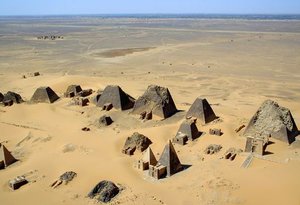|
|
MeroŽ is the name of an ancient city on the east bank of the Nile north of Khartoum, Sudan. Near the site are a group of villages called Bagrawiyah. This city was the capital of the Kingdom of Kush for several centuries. The city gave its name to the Island of MeroŽ for the "Dongola Reach" of the Nile, a region bounded on three sides by the Nile (from the Atbarah River to Khartoum), the Atbarah, and the Blue Nile.
The site of the city of MeroŽ is marked by over two hundred pyramids in three groups, of which many are in ruinous condition, and is part of a group of archeological sites that was included by UNESCO, in 2003, in the list of the World Heritage.
Archaeology at MeroŽ
Modern archaeology in Sudan has been impossible because of the on-going civil war. In the 19th century, after the ruins at MeroŽ had been described by several European travellers, some treasure-hunting excavations were executed on a small scale in 1834 by Giuseppe Ferlini, who discovered (or professed to discover) various antiquities, chiefly in the form of jewelry, now in the museums of Berlin and Munich. The ruins were examined more carefully in 1844 by Karl Richard Lepsius, who brought many plans, sketches and copies, besides actual antiquities, to Berlin. Further excavations were carried on by E. A. Wallis Budge in the years 1902 and 1905, the results of which are recorded in his work, The Egyptian Sudan: its History and Monuments (London, 1907). Troops were furnished by Sir Reginald Wingate, governor of the Sudan, who made paths to and between the pyramids, and sank shafts, etc. It was found that the pyramids were regularly built over sepulchral chambers, containing the remains of bodies either burned or buried without being mummified. The most interesting objects found were the reliefs on the chapel walls, already described by Lepsius, and containing the names with representations of queens and some kings, with some chapters of the Book of the Dead; some stelae with inscriptions in the Meroitic language, and some vessels of metal and earthenware. The best of the reliefs were taken down stone by stone in 1905, and set up partly in the British Museum and partly in the museum at Khartoum. In 1910, in consequence of a report by Professor Sayce, excavations were commenced in the mounds of the town and the necropolis by J. Garstang on behalf of the University of Liverpool, and the ruins of a palace and several temples were discovered, built by the Meroite kings.
History of MeroŽ
MeroŽ was the capital of the Kushite Kingdom or Meroitic Empire that spanned the period c.800 BCE - 300 CE.
An unnamed king of Axum erected a victory stele in Greek at the site of MeroŽ; from his description that he was "King of the Axumites and the Omerites", it is likely this king ruled sometime around 300. Two more inscriptions in archaic Ge'ez script have been found on nearby pyramids; it is uncertain whether they are contemporary with the royal stele, or belong to a later date.
MeroŽ was probably also an alternative name for the city of Napata, the ancient capital of one of the Kushite kingdoms, built at the foot of Jebel Barkal. The site of Napata is indicated by the villages of Sanam Abu Dom on the left bank of the Nile and Old Merawi on the right bank of the river. New Merawi, 1 mile east of Sanam Abu Dom and on the same side of the river, was founded by the Sudan government in 1905 and made the capital of the mudiria of Dongola.
See also
- LearningSites.com - Gebel Barkal (http://www.learningsites.com/GebelBarkal-2/GB-index.htm)
- UNESCO World Heritage - Gebel Barkal and the Sites of the Napatan Region (http://whc.unesco.org/pg.cfm?cid=31&id_site=1073)
- List of World Heritage Sites in Africade:Meroe

